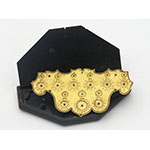This calculating machine is a money adder similar to those invented and built by Samuel Morland in ca. 1666. It consists of a thin gilded brass plate which carries, on the upper part, six main disks numbered from 0 to 9, and on the lower part, three main disks numbered respectively from 0 to 19, from 0 to 11, and from 0 to 6. A smaller auxiliary disk is internally connected to each main disk. This arithmetic machine cannot transfer carries from one order to the subsequent, but each auxiliary disks advances of one unit when the respective main disk exceeds 9 (for the upper six), or 6, 11, 19 respectively (for the lower three). The upper disks were used for pounds, the two lower disks on the right for shillings and pence. The lower disk on the left was possibly used for the German gulden, divided in 7 long schillings. Donated by Tito Livio Burattini to Ferdinand II de’ Medici.









